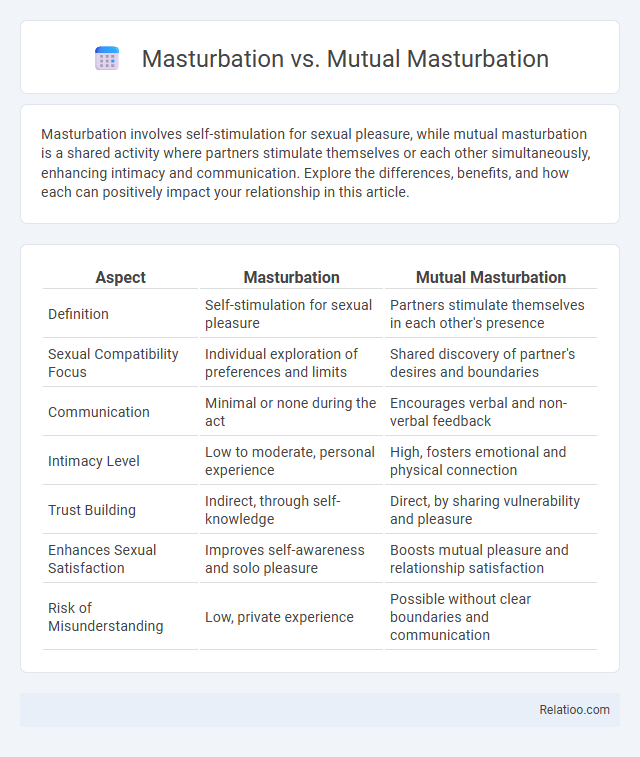Masturbation involves self-stimulation for sexual pleasure, while mutual masturbation is a shared activity where partners stimulate themselves or each other simultaneously, enhancing intimacy and communication. Explore the differences, benefits, and how each can positively impact your relationship in this article.
Table of Comparison
| Aspect | Masturbation | Mutual Masturbation |
|---|---|---|
| Definition | Self-stimulation for sexual pleasure | Partners stimulate themselves in each other's presence |
| Sexual Compatibility Focus | Individual exploration of preferences and limits | Shared discovery of partner's desires and boundaries |
| Communication | Minimal or none during the act | Encourages verbal and non-verbal feedback |
| Intimacy Level | Low to moderate, personal experience | High, fosters emotional and physical connection |
| Trust Building | Indirect, through self-knowledge | Direct, by sharing vulnerability and pleasure |
| Enhances Sexual Satisfaction | Improves self-awareness and solo pleasure | Boosts mutual pleasure and relationship satisfaction |
| Risk of Misunderstanding | Low, private experience | Possible without clear boundaries and communication |
Understanding Masturbation: An Overview
Masturbation involves self-stimulation of the genitals for sexual pleasure, promoting individual exploration and sexual health. Mutual masturbation occurs when partners simultaneously stimulate themselves or each other, enhancing intimacy and communication while reducing risks associated with intercourse. Understanding these practices highlights their roles in personal satisfaction, relationship dynamics, and safe sexual expression.
What Is Mutual Masturbation?
Mutual masturbation involves partners stimulating themselves in each other's presence, enhancing intimacy and communication without direct genital contact. Unlike solo masturbation, which is an individual activity, mutual masturbation allows sharing pleasure and exploring each other's bodies safely. This practice can strengthen emotional bonds and improve sexual satisfaction, making your intimate experiences more connected.
Psychological Benefits of Solo Masturbation
Solo masturbation offers unique psychological benefits including enhanced self-awareness, stress relief, and improved mood through the release of endorphins. Unlike mutual masturbation, which can strengthen emotional intimacy, solo masturbation fosters a personal connection with your own body and sexual preferences. Understanding these distinctions helps you prioritize individual mental well-being alongside shared experiences.
Exploring the Intimacy of Mutual Masturbation
Mutual masturbation involves partners simultaneously stimulating themselves while sharing the experience, enhancing intimacy through vulnerability and communication. This practice fosters emotional connection by allowing partners to express desires openly, distinct from solo masturbation which is a private, individual act focusing on personal pleasure. Exploring mutual masturbation can deepen trust and understanding, enriching the sexual relationship beyond physical gratification.
Health Benefits: Solo vs Mutual Masturbation
Solo masturbation promotes personal body awareness, stress relief, and can improve sleep quality by releasing endorphins. Mutual masturbation enhances intimacy and communication between partners, strengthening emotional bonds while sharing sexual pleasure in a safe and consensual way. Your choice between solo and mutual masturbation impacts physical and psychological health benefits, with each offering unique advantages for sexual well-being.
Communication and Consent in Mutual Masturbation
Mutual masturbation fosters open communication and explicit consent, creating a safe space where partners express boundaries and desires clearly. You can enhance intimacy by discussing comfort levels and preferences before and during the experience, which differentiates it from solo masturbation where communication is inherently absent. Prioritizing consent in mutual masturbation strengthens trust and ensures both partners feel respected and empowered throughout the interaction.
Myths and Misconceptions Debunked
Masturbation, mutual masturbation, and partnered sexual activities are often surrounded by myths that inaccurately portray their safety and moral implications. Your sexual health benefits from understanding that masturbation is a natural, harmless activity that can enhance intimacy when shared mutually, dispelling misconceptions about guilt, addiction, or negative physical effects. Scientific studies confirm these practices are safe and positive expressions of sexuality, countering cultural stigma and promoting healthier attitudes toward personal and shared pleasure.
Masturbation: Privacy, Comfort, and Self-Discovery
Masturbation offers a private and comfortable environment for individuals to explore their own bodies and desires without external pressures. It serves as a key practice for self-discovery, helping individuals understand their sexual preferences, boundaries, and responses. Compared to mutual masturbation, which involves shared intimacy, solo masturbation emphasizes personal security and self-awareness in sexual health.
Enhancing Relationships Through Mutual Masturbation
Mutual masturbation fosters intimacy by allowing partners to explore each other's desires and boundaries, enhancing communication and trust in relationships. Unlike solo masturbation, it creates shared experiences that deepen emotional connections and improve sexual satisfaction. You can strengthen your bond by embracing mutual masturbation as a meaningful way to discover pleasure together.
Safe Practices and Sexual Wellness Tips
Masturbation, mutual masturbation, and partnered masturbation each offer unique benefits for sexual wellness while maintaining safety through hygiene and communication. Your safest practices include thorough handwashing, using barriers like gloves or condoms during mutual activities, and open dialogue about boundaries and consent to prevent infections and enhance intimacy. Prioritizing these measures helps you enjoy sexual expression responsibly, reduce risks of sexually transmitted infections, and foster emotional connection.

Infographic: Masturbation vs Mutual Masturbation
 relatioo.com
relatioo.com